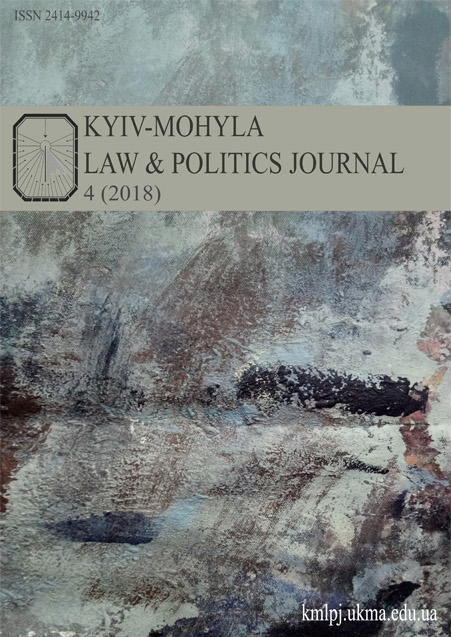Europeanization Through EU External Agreements and the Issue of “Constitutional Identity”: The Case of the EU-Armenia CEPA
DOI:
https://doi.org/10.18523/kmlpj153250.2018-4.15-52Keywords:
Europeanization, EU common values, principles of EU law, legislative approximation, legal reforms, constitutional identity, CEPA, ArmeniaAbstract
Using the concept of “constitutional identity” as a theoretical basis, this article analyses the potential transformative influence of the EU-Armenia Comprehensive and Enhanced Partnership Agreement (CEPA) on the Armenian legal system. In particular, the author focuses on the Agreement’s capacity to stimulate the implementation of the EU’s “common values” and transpose the norms, general principles, and methodological approaches of EU law into the domestic legal order. It is argued that this potential depends on two elements of the “constitutional identity” of the Armenian legal order: its axiological core and its openness to external influences.
References
- Avbelj, Matej. “Pluralism and Systemic Defiance in the EU.” In The Enforcement of EU Law and Values: Ensuring Member States’ Compliance, edited by Andras Jakab and Dimitry Kochenov, 44–64. Oxford: Oxford University Press, 2017. https://doi.org/10.1093/acprof:oso/9780198746560.001.0001
- Börzel, Tanja A., and Yasemin Pamuk. “Europeanization Subverted? The European Union’s Promotion of Good Governance and the Fight Against Corruption in the South Caucasus.” KFG Working Paper No. 26 (April 2011). http://userpage.fu-berlin.de/kfgeu/kfgwp/wpseries/WorkingPaperKFG_26.pdf.
- Börzel, Tanja A., and Yasemin Pamuk. “Pathologies of Europeanization: Fighting Corruption in the Southern Caucasus.” West European Politics 35.1 (2011): 79–97. https://doi.org/10.1080/01402382.2012.631315
- Cloots, Elke. “National Identity, Constitutional Identity, and Sovereignty in the EU.” Netherlands Journal of Legal Philosophy 2.45 (2016): 82–98. https://doi.org/10.5553/njlp/.000049
- Cotterrell, Roger. Law, Culture and Society: Legal Ideas in the Mirror of Social Theory. London: Routledge, 2006.
- Cremona, Marise. “The ENP and Multilateralism.” In The European Neighbourhood Policy—Values and Principles, edited by Sara Poli, 81–98. Abingdon, Oxon; New York, NY: Routledge, 2016.
- Delcour, Laure, and Kataryna Wolczuk. “The EU’s Unexpected ‘Ideal Neighbour’? The Perplexing Case of Armenia’s Europeanisation.” Journal of European Integration 37.4 (2015): 491–507. https://doi.org/10.1080/07036337.2015.1004631
- Delegation of the European Union to Armenia. “Step Forward for EU-Armenia Relations as New Agreement is Provisionally Applied” (June 1, 2018). Accessed June 1, 2018. https://eeas.europa.eu/delegations/armenia/45736/step-forward-eu-armeniarelations-new-agreement-provisionally-applied_en.
- Dragneva, Rilka, Laure Delcour, and Laurynas Jovanicius. “Assessing Legal and Political Compatibility between European Union Engagement Strategies and Membership of the Eurasian Economic Treaty.” EU-STRAT Working Paper No. 2 (November 2017).
- Faraguna, Pietro. “Constitutional Identity in the EU—A Shield or a Sword?” German Law Journal 18.7 (2017): 1617–1640. https://doi.org/10.1017/s207183220002246x
- Ghazaryan, Narine, and Anna Hakobyan. “Legislative Approximation and Application of EU Law in Armenia.” In Legislative Approximation and Application of EU Law in the Eastern Neighbourhood of the European Union, edited by Peter Van Elsuwege and Roman Petrov, 191–214. London: Routledge, 2014.https://doi.org/10.4324/9780203799178-11
- Ghazaryan, Narine. “A New Generation of Human Rights Clauses? The Case of Association Agreements in the Eastern Neighbourhood.” European Law Review 40.3 (2015): 391–410.
- Ginsburg, Tom, and Mila Versteeg. “Constitutional Correlates and the Rule of Law.” In Constitutionalism and the Rule of Law: Bridging Idealism and Realism, edited by Maurice Adams, Anne Meuwese and Ernst Hirsch Ballin, 506–525. Cambridge; New York: Cambridge University Press, 2017. https://doi.org/10.1017/9781316585221.017
- Gstöhl, Sieglinde.”Differentiated Integration and the NEC.” In Legislative Approximation and Application of EU Law in the Eastern Neighbourhood of the European Union, edited by Peter Van Elsuwege and Roman Petrov, 89–107. London; New York: Routledge, 2014. https://doi.org/10.18523/kmlpj52715.2015-1.245-246
- Häberle, Peter. “The Constitutional State and Its Reform Requirements.” Ratio Juris 13.1 (2000): 77–94. Cited in: Yaniv Roznai, “Towards a Theory of Constitutional Unamendability,” Jus Politicum 18 (2017): 5–37. http://juspoliticum.com/uploads/ jp18-t01_roznai.pdf. https://doi.org/10.1111/1467-9337.00141
- Jacobsohn, Gary Jeffrey. “Constitutional Identity.” The Review of Politics 68 (2006): 361–397.
- Khvorostiankina, Anna. “Legislative Approximation and Application of EU Law in Moldova.” In Legislative Approximation and Application of EU Law in the Eastern Neighbourhood of the European Union, edited by Roman Petrov and Peter Van Elsuwege, 159–178. London; New York: Routledge, 2014. https://doi.org/10.4324/9780203799178-9
- Kochenov, Dimitry. “The Issue of Values.” In Legislative Approximation and Application of EU Law in the Eastern Neighbourhood of the European Union, edited by Roman Petrov and Peter Van Elsuwege, 46–62. London; New York: Routledge, 2014. https://doi.org/10.18523/kmlpj52715.2015-1.245-246
- Kostanyan, Hrant, and Richard Giragosian. “EU-Armenian Relations: Charting a Fresh Course.” CEPS Research Report No. 2017–14, November 2017. https://ssrn.com/abstract=3075166.
- Kühn, Zdeněk. “The Application of European Law in the New Member States: Several (Early) Predictions.” German Law Journal 6.3 (2005): 563–582. https://doi.org/10.1017/s207183220001381x
- Marti, Jose Luis. “Two Different Ideas of Constitutional Identity: Identity of the Constitution v. Identity of the People.” In National Constitutional Identity and European Integration, edited by Alejandro Saiz Arnaiz and Carina Alcoberro Llivina, 17–36. Antwerp: Intersentia, 2013.
- Mazzone, Jason. “The Creation of a Constitutional Culture.” Tulsa Law Review 40.4 (2004): 671–698.
- Meleshevych, Andriy, and Anna Khvorostyankina. “Ukraine.” In The European Convention on Human Rights and fundamental freedoms in Central and Eastern Europe, edited by Leonard Hammer and Frank Emmert, 557–596. The Hague: Eleven International Publishing, 2012. https://doi.org/10.1017/s2044251313000118
- Mogherini, Federica. Remarks by High Representative/Vice-President Federica Mogherini Following the Signing of the European Union-Armenia Comprehensive and Enhanced Partnership Agreement (CEPA) with Edward Nalbandian, Minister of Foreign Affairs of Armenia, Brussels, November 24, 2017. Accessed November 26, 2017. https://eeas.europa.eu/delegations/armenia/36208/remarks-hrvp-federicamogherini-following-signing-european-union-armenia-comprehensive-and_en. https://doi.org/10.1163/1570-6664_iyb_sim_person_53329
- Pavone, Tommaso. Constitutional Identity: An Overview and Some Conceptual Concerns, April 23, 2014. https://scholar.princeton.edu/sites/default/files/tpavone/files/ jacobsohn-_constitutional_identity_critical_review.pdf.
- Payaslian, Simon. The Political Economy of Human Rights in Armenia: Authoritarianism and Democracy in a Former Soviet Republic. London: I. B. Tauris, 2011.
- Petrov, Roman, Guillaume Van der Loo, and Peter Van Elsuwege. “The EU-Ukraine Association Agreement: A New Legal Instrument of Integration Without Membership?” Kyiv-Mohyla Law and Politics Journal 1 (2015): 1–19. https:// doi.org/10.18523/kmlpj52678.2015–1.1–19.
- Petrov, Roman. “EU Values in Integration-Oriented Agreements with Ukraine, Moldova and Georgia.” In The European Neighbourhood Policy—Values and Principles, edited by Sara Poli, 99–112. Abingdon, Oxon; New York, NY: Routledge, 2016.
- Pilsen, Monika.”Constitutional Identity, Unconstitutional Amendments and the Idea of Constituent Power: The Development of the Doctrine of Constitutional Identity in German Constitutional Law.” I*CON, 14 (2016): 411–438. https://doi.org/10.1093/icon/mow035
- Poli, Sara. “Introduction.” In The European Neighbourhood Policy –Values and Principles, edited by Sara Poli, 1–8. Abingdon, Oxon; New York, NY: Routledge, 2016.
- Prime Minister. Official web-site. Video of press-conference, July 12, 2018. Accessed July 14, 2018. http://www.primeminister.am/hy/videos/item/9MrD1Vs-F0A/.
- Radaelli, Claudio M. “Whither Europeanization? Concept Stretching and Substantive Change.” European Integration Online Papers 4.8 (2000): 1–28. https://ssrn.com/abstract=302761. https://doi.org/10.2139/ssrn.302761
- Robertson, David. The Judge as Political Theorist: Contemporary Constitutional Review. Princeton: Princeton University Press, 2010.
- Rodiņa, Anita, and Janis Pleps. “Constitutionalism in Latvia: Reality and Developments.” In New Millennium Constitutionalism: Paradigms of Reality and Challenges, with a foreword of Dr. G. G. Harutyunyan, 431–472. Yerevan: Njhar, 2013.
- Rosenfeld, Michel. “Constitutional Identity.” In The Oxford Handbook on Comparative Constitutional Law, edited by Michel Rosenfeld and András Sajó, 756–776. Oxford: Oxford University Press, 2012. https://doi.org/10.1093/oxfordhb/9780199578610.013.0019
- Rosenfeld, Michel. “The Constitutional Subject, Its Other, and the Perplexing Quest for an Identity of Its Own: A Reply to My Critics.” Cardozo Legal Studies 358 (2012): 1–29. https://ssrn.com/abstract=2021356.
- Safjan, Marek. “Political and Constitutional Courts. A Judge’s Personal Perspective.” EUI Working Paper Law 10 (2008): 1–23. http://cadmus.eui.eu/handle/1814/8101.
- Saiz Arnaiz, Alejandro, and Carina Alcoberro Llivina. “Why Constitutional Identity Suddenly Matters: A Tale of Brave States, a Mighty Union and Decline of Sovereignty.” In National Constitutional Identity and European Integration, edited by Alejandro Saiz Arnaiz and Carina Alcoberro Llivina, 1–15. Antwerp: Intersentia, 2013.
- Schimmelfennig, Frank. “Europeanization Beyond Europe.” Living Reviews in European Governance 7.1 (2012): 1–31. Accessed June 25, 2018. http://www.europeangovernancelivingreviews.org/Articles/lreg 2012–1/download/lreg 2012–1Color.pdf. https://doi.org/10.12942/lreg-2012-1
- Śledzińska-Simon, Anna. “Constitutional Identity in 3D: A Model of Individual, Relational, and Collective Self and its Application in Poland.” International Journal of Constitutional Law 13.1 (2015): 124–155. https://doi.org/10.1093/icon/mov007
- Van der Loo, Guillaume. “The EU-Ukraine DCFTA.” In Legislative Approximation and Application of EU Law in the Eastern Neighbourhood of the European Union, edited by Peter Van Elsuwege and Roman Petrov, 63–88. London; New York: Routledge, 2014. https://doi.org/10.4324/9780203799178-5
- Von Bogdandy Armin, Piotr Bogdanowicz, Iris Canor, Maciej Taborowski, Matthias Schmidt. “A Constitutional Moment for the European Rule of Law—Upcoming Landmark Decisions Concerning Polish Judiciary.” MPIL Research Paper Series 10 : 1–13. Accessed June 25, 2018. https://ssrn.com/abstract=3199809.
- Von Bogdandy, Armin. “Pluralism, Direct Effect, and the Ultimate Say: On the Relationship Between Iinternational and Domestic Constitutional Law.” International Journal of Constitutional Law 6.3–4 (2008): 397–413. https://doi.org/10.2139/ssrn.3199809
- Vorländer, Hans. “Gründung und Geltung: Die Konstitution der Ordnung und die Legitimität der Konstitution.” In Geltungsgeschichten: Über die Stabilisierung und Legitimierung institutioneller Ordnungen, ed. Gert Melville and Hans Vorländer. Cologne; Weimar; Vienna: Böhlau, 2002. Cited in: Silke Hensel, Ulrike Bock, Katrin Dircksen and Hans-Ulrich Thamer, ed., Constitutional Cultures: On the Concept and Representation of Constitutions in the Atlantic World. Newcastle upon Tyne: Cambridge Scholars Publishing, 2012. https://doi.org/10.1093/icon/mon015
- Žalimas, Dainius. “Eternity Clauses: a Safeguard of Democratic Order and Constitutional Identity.” Speech of the President of the Constitutional Court of Lithuania. Accesssed November 1, 2017. http://www. gjk-ks.org/repository/docs/Speech_of_the_President_of_the_Constitutional_Court_of_Lithuania_Prof.Dr._Dainius_ alimas.pdf.
- Siegel, Andrew M. “Constitutional Theory, Constitutional Culture.” Journal of Constitutional Law 18.4 (2016): 1067–1128
- Siegel, Andrew M. “Constitutional Theory, Constitutional Culture.” Journal of Constitutional Law 18.4 (2016): 1067–1128
Downloads
Published
How to Cite
Issue
Section
License
Copyright (c) 2018 Anna Khvorostiankina

This work is licensed under a Creative Commons Attribution 4.0 International License.
Kyiv-Mohyla Law and Politics Journal provides free access to original research without restriction barriers (i.e. subscription fees, licensing fees etc.).
Unless otherwise indicated, content is licensed under the Creative Commons Attribution 4.0 International (CC BY 4.0) license, which means you are free to:
distribute, remix, tweak, and build upon your work, even commercially
...provided that any use is made with attribution to author(s) and Kyiv-Mohyla Law and Politics Journal.
The copyright in the article or any other submission to Kyiv-Mohyla Law and Politics Journal shall remain with the author(s).
The journal allows the author(s) to hold the copyright without restrictions and will retain publishing rights without restrictions.





